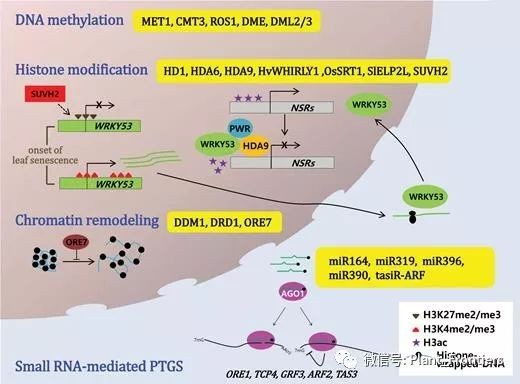博文
J EXP BOT:叶片衰老相关表观遗传调控综述
||
Beyond the genetic code in leaf senescence
Leaf senescence (叶片衰老) is not only genetically programmed but also induced by exogenous stress (外源胁迫) to ensure completion of the plant life cycle, successful reproduction and environmental adaptability. Genetic reprogramming is a major aspect of leaf senescence, and the senescence signaling that follows is controlled by a complex regulatory network. Recent studies suggest that the activity of transcription factors together with epigenetic mechanisms (表观遗传学机制) ensures the robustness of this network, with the latter including chromatin remodeling (染色质重塑), DNA modification, and RNA-mediated control of transcription factors and other senescence-associated genes. In this review, we provide an overview of the relevant epigenetic mechanisms and summarize recent findings of epigenetic regulators of plant leaf senescence involved in DNA methylation and histone modification along with the functions of small RNAs in this process.
叶片衰老不仅是由遗传编程引起的,而且还有外源胁迫的诱导,以保证植物生命周期的完成、繁殖成功以及环境适应性。遗传重编程是叶片衰老的一个重要方面,其衰老信号是由复杂的调控网络所控制的。最近的研究表明,转录因子的活性和表观遗传学机制共同作用于这一网络,后者包括了染色质重塑、DNA修饰以及RNA介导的转录因子和其他衰老相关基因的调控。在这篇综述中,作者概述了植物叶片衰老相关的表观遗传学机制,包括DNA甲基化和组蛋白修饰,以及小RNAs在这个过程中的功能。
doi: https://doi.org/10.1093/jxb/erx401
https://blog.sciencenet.cn/blog-3158122-1090148.html
上一篇:Plant Physiology:水稻OsCPK4调控水稻先天性免疫
下一篇:PLOS Genetics:豌豆中生长素与独脚金内酯的内稳态调节
全部作者的其他最新博文
- • Plant Physiology:CsMADS3促进柑果中的叶绿素降解和类胡萝卜素合成(华中农业大学)
- • Molecular Plant:LBD11-ROS反馈调节作用于拟南芥的维管形成层增殖和次生生长(浦项科技大学)
- • Science Advances:根结线虫通过调控植物的CLE3-CLV1模块,促进侵染进程(日本熊本大学)
- • Nature Communications:油菜素内酯参与植物营养生长期转变的分子机制解析(浙江农林大学)
- • Current Biology:光合作用产生的蔗糖驱动侧根“生物钟”(德国弗莱堡大学)
- • PNAS:花同源异型基因在叶中被抑制、花中被激活的分子机制(南卡罗来纳大学)
